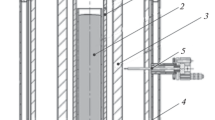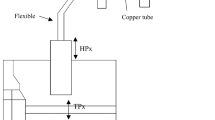Abstract
Prediction of the dynamic behavior of electrodes of the electric arc furnace (EAF) fed by AC current is rather difficult because of several phenomena superposed, particularly during the first step of the melting process, i.e. the so-called perforation, and in case of the melting of scrap. Unexpected ruptures of electrodes are often observed as a consequence of vibration. Dynamic excitation is applied by the vertical position control of the mast supporting the electrodes and by the Lorentz’s forces generated by the magnetic flux provided by each electric phase. Moreover, the irregular distribution of stiffness along the electrode, being due to the sensitivity of the material properties upon temperature, affects quite a lot the dynamic response of this structure. To identify the origin of the observed ruptures and to suitably predict the dynamic behavior of the whole system a modeling activity was performed. A numerical model of the EAF structures was built, by resorting to an integrated approach based on the finite element method and on the multi body dynamics, then it was preliminarily validated on an existing plant. It was demonstrated that stiffening effect upon the graphite electrode induced by the temperature distribution makes dangerous the action of the vertical position control, when it is applied too fast and excites the flexural modes of the electrode. Numerical model allowed refining the design of the electrode and improving the safety factor as well as finding some design requirement to suitably limit the operation of the position control system.









Similar content being viewed by others
Abbreviations
- AC:
-
Alternate current
- C 0 :
-
Thermal expansion coefficient at 100 °C
- C th :
-
Thermal expansion coefficient at current temperature
- D :
-
Diameter of the electrode
- E :
-
Elastic coefficient, Young’s modulus
- EAF:
-
Electric Arc Furnace
- EMF:
-
Electro-Motive Force
- E ref :
-
Reference Young’s modulus (computation of the distribution along the electrode)
- FEM:
-
Finite Element Method
- G :
-
Tangential elastic modulus
- I :
-
Transversal inertia of the electrode cross section
- I p :
-
Polar inertia of the electrode cross section
- K :
-
Elastic constant
- M :
-
Torque applied to the electrode
- MBD:
-
Multi Body Dynamics
- T :
-
Temperature
- T 21 °C :
-
Temperature at 21 °C
- T ref :
-
Reference temperature for the computation of the distribution along the electrode
- x :
-
Distance between the cross section and the gripper along the electrode length
- x,y,z :
-
Coordinates of the global reference of the EAF system
- ΔC th :
-
Increment of thermal expansion coefficient
- ΔT a :
-
Increment of temperature along the axial direction of the electrode
- ΔT c :
-
Increment of temperature along the circumferential direction of the electrode
- ΔT r :
-
Increment of temperature along the radial direction of the electrode
- εa :
-
Axial strain inside the electrode material
- εc :
-
Circumferential strain inside the electrode material
- εr :
-
Radial strain inside the electrode material
- σa :
-
Axial strain inside the electrode material
- σc :
-
Circumferential strain inside the electrode material
- σr :
-
Radial strain inside the electrode material
- θ:
-
Cross section rotation in torsion
- v :
-
Poisson’s coefficient
References
Taylor C (1975) Electric furnace steelmaking. AIME—Iron and Steel Society, Warrendale
Di Stasi L (1976) Forni Elettrici. Patron, Padova
Brusa E, Franceschinis E, Morsut S (2009) Compact modelling of electric arc furnace electrodes for vibration analysis, detection and suppression. CMES-Comput Model Eng Sci 42(2):75–106
Bosso N, Brusa E, Zampieri N, Morsut S, Picciotto M (2012) Electromechanical coupled response of the AC electric arc furnace structures during the scrap melting process. Proceedings of ASME Biennal International Conference of Engineering Design and System Analysis—ESDA, July 2012, Vol. 1, Nantes, p 459–468
Wolf A, Manoharan T (2000) Reactive power reduction in three-phase electric arc furnace. IEEE Trans Ind Electr 47(4):729–733
Montanari GC et al. (1993) The effects of series inductors for flicker reduction in electric power systems supplying arc furnaces. Proc IEEE IAS’93 2:1496–1503
Mendis SR, Bishop MT, Witte JF (1996) Investigations of voltage flicker in electric arc furnace power systems. IEEE Ind Appl Mag 2(1):28–34
Lu CW, Huang SJ, Huang CL (2000) Flicker characteristic estimation of an AC electric arc furnace. Electr Power Syst Res 54:121–130
GrafTech International (2013) UCAR® Grade AGX™ Graphite Electrodes for EAF Applications, http://www.graftech.com. Accessed 23 Nov 2013
SGL CARBON GmbH (2013) Graphite Electrodes, www.sglgroup.com. Accessed 23 Nov 2013
Avoledo A, Bosso N, Brusa E, Morsut S, Picciotto M (2012) Numerical modeling and dynamic behavior prediction of AC electric arc furnace structures during the scrap melting process. Proceedings of ASMET European Steel Making Conference, EEC 2012, 25–28 September 2012, Graz
Gerhan R, Krotov Y, Lugo N (2010) Secondary system mechanical resonance in new tall-shell SDI-Butler arc furnaces: detection and solutions, Proceedings of AISTech Conference and Experiments, 1, Pittsburgh
Boulet B, Lalli G, Ajersch M (2003) Modeling and control of an electric arc furnace. Proceedings of American Control Conference, Denver
Rathaba LP (2005) Model fitting for electric arc furnace refining, PhD. Thesis, University of Pretoria
Bălan R, Mătieş V, Hancu O, Stan S, Ciprian L (2007) Modeling and control of an electric arc furnace. Proceedings of Mediterranean Conference on Automation and Control, Athens
MacRosty R, Swartz C (2007) Dynamic optimization of electric arc furnace operation. AIChE Journal 53(3)
Janabi-Sharifi JG (2009) An adaptive system for modeling and simulation of electrical arc furnaces. Control Eng Pract 17(10):1202–1219
Varadan S, Makram EB, Girgis AA (1996) A new time domain voltage source model for an arc furnace using EMTP). IEEE Trans Power Deliv 11(3):1685–1691
Tseng K, Wang Y, Vilathgamuwa DM (1997) An experimentally verified hybrid Cassie-Mayr electric arc model for power electronic simulations. IEEE Trans Power Electron 12(3):429–436
Bowman B, Krüger K (2009) Arc furnace physics. Stahleisen Communications, Düsseldorf
Kiyoumarsi A, Hassanzadeh MR, Kouhi-Fayegh-Dehkordi A, Hatam-Poor A, Moalem M (2010) Two dimensional time-stepping finite element analysis of a three phase electric arc furnace. Electr Eng 92:141–149
Arzpeyma N (2011) Modeling of Electric Arc Furnaces (EAF) with electromagnetic stirring. M.D. Project, Deptartment of Materials Science and Engineering, Royal Institute of Technology, Stockholm
Wendelstorf J, Spitzer KH (2006) A process model for EAF steelmaking. Proceedings of AISTech 2006, May 1–4, Cleveland
Sadeghian A, Lavers JD (2011) Dynamic reconstruction of nonlinear V-I characteristic in electric arc furnaces using adaptive neuro-fuzzy rule-based networks. Appl Soft Comput 11:1448–1456
Juvinall RC, Marshek KM (2006) Fundamentals of machine component design. John Wiley & Sons, New York
Sato S, Ishida R, Imamura Y, Miyata I, Kimura T (1997) Theory and experiments of thermal stress fracture of graphite electrodes for steelmaking arc furnaces. Carbon 35(3):353–363
Genta G (2009) Vibration dynamics and control. Springer, New York
Jones J, Bowman B, Lefrank PA (1998) Electric Furnace Steelmaking in Steelmaking and Refining Volume of The AISE Steel Foundation
Harvel GD, Chang JS (2009) Nondestructive evaluation of multiply connected electrical arc furnace graphite rod electrodes. Res Nondestr Eval 20(4):215–229
Li T, Wang Z, Wang N (2012) Temperature field analysis and adaptive neuro-fuzzy inference system for MgO single crystal production. J Wuhan Univ Tech Mater Sci 6:19
Salgado Rodriguez P (2002) Mathematical and numerical analysis of some electromagnetic problems application to the simulation of metallurgical electrodes. PhD. Thesis, University of de Santiago de Compostela
Author information
Authors and Affiliations
Corresponding author
Rights and permissions
About this article
Cite this article
Brusa, E. Thermomechanical coupling effect of graphite electrodes upon the electric arc furnace dynamics. Meccanica 49, 2979–2990 (2014). https://doi.org/10.1007/s11012-014-0023-x
Received:
Accepted:
Published:
Issue Date:
DOI: https://doi.org/10.1007/s11012-014-0023-x




